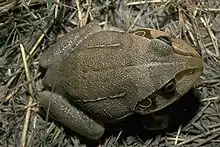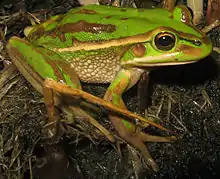Ranoidea (genus)
Ranoidea is a genus of frogs in the subfamily Pelodryadinae. They are found in Australia, New Guinea, and two nearby groups of islands: the Maluku Islands, and the Louisiade Archipelago.[1] The circumscription of this taxon is still controversial.

| Ranoidea | |
|---|---|
 | |
| Ranoidea aurea, the type species | |
| Scientific classification | |
| Kingdom: | Animalia |
| Phylum: | Chordata |
| Class: | Amphibia |
| Order: | Anura |
| Family: | Pelodryadidae |
| Subfamily: | Pelodryadinae |
| Genus: | Ranoidea Tschudi, 1838 |
| Type species | |
| Ranoidea jacksoniensis Tschudi, 1838 | |
| Synonyms[1] | |
| |
Taxonomy
Species in this genus were until recently placed in the then-paraphyletic genus Litoria; many of them had been placed in even larger Hyla before. However, in 2016 Duellman and colleagues split Litoria into several genera.[1][2] The systematic and taxonomic conclusions based on Duellman et al.[2] should be treated with caution, because 78.9% of individuals (397/503) used in the concatenated analyses had less than half of the gene sequences available for the 19 genes used. Missing data can be problematic in phylogenetic analyses (e.g.[3][4][5][6]) and lead to erroneous conclusions about systematic relationships. Additionally, there is no mention of checking for base-composition bias amongst taxa (non-stationarity), which can also lead to incorrect tree phylogenies (e.g.[7][8]). The species now in Ranoidea were placed in the genus Dryopsophus. However, the oldest available name for these species is Ranoidea.[1] These changes are not yet widely recognized or accepted,[9] and the AmphibiaWeb continues to recognize Litoria in the older, broad sense.[10] The AmphibiaWeb also recognizes Cyclorana,[10] a position that, without additional amendments, renders Ranoidea paraphyletic; it may be treated as a subgenus.[1]
Some controversy also surrounds whether the subfamily Pelodryadinae is part of the family Pelodryadidae, as suggested by Duellman and colleagues[2] and recognized in the Amphibian Species of the World,[1] or part of the family Hylidae, as recognized in the AmphibiaWeb.[10]
Description and ecology
The pupil is horizontally elliptical, and the palpebral membrane is unpigmented. Many species have tadpoles that develop in mountain streams and have enlarged ventral mouths.[2] However, "Cyclorana" are adapted to standing and often temporary bodies of water.[11]
Species
The following species are recognised in the genus Ranoidea:[1]
- Ranoidea alboguttata (Günther, 1867)
- Ranoidea andiirrmalin (McDonald, 1997)
- Ranoidea aruensis (Horst, 1883)
- Ranoidea auae (Menzies and Tyler, 2004)
- Ranoidea aurea (Lesson, 1829)
- Ranoidea australis (Gray, 1842)
- Ranoidea barringtonensis (Copland, 1957)
- Ranoidea becki (Loveridge, 1945)
- Ranoidea bella (McDonald, Rowley, Richards, and Frankham, 2016)
- Ranoidea booroolongensis (Moore, 1961)
- Ranoidea brevipes (Peters, 1871)
- Ranoidea brongersmai (Loveridge, 1945)
- Ranoidea bulmeri (Tyler, 1968)
- Ranoidea caerulea (White, 1790)
- Ranoidea callista (Kraus, 2013)
- Ranoidea cavernicola (Tyler and Davies, 1979)
- Ranoidea chloris (Boulenger, 1892)
- Ranoidea citropa (Péron, 1807)
- Ranoidea cryptotis (Tyler and Martin, 1977)
- Ranoidea cultripes (Parker, 1940)
- Ranoidea cyclorhynchus (Boulenger, 1882)
- Ranoidea dahlii (Boulenger, 1896)
- Ranoidea daviesae (Mahony, Knowles, Foster, and Donnellan, 2001)
- Ranoidea dayi (Günther, 1897)
- Ranoidea dorsivena (Tyler, 1968)
- Ranoidea elkeae (Günther and Richards, 2000)
- Ranoidea eschata (Kraus and Allison, 2009)
- Ranoidea eucnemis (Lönnberg, 1900)
- Ranoidea exophthalmia (Tyler, Davies, and Aplin, 1986)
- Ranoidea fuscula (Oliver and Richards, 2007)
- Ranoidea genimaculata (Horst, 1883)
- Ranoidea gilleni (Spencer, 1896)
- Ranoidea gracilenta (Peters, 1869)
- Ranoidea graminea (Boulenger, 1905)
- Ranoidea impura (Peters and Doria, 1878)
- Ranoidea jungguy (Donnellan and Mahony, 2004)
- Ranoidea kroombitensis (Hoskin, Hines, Meyer, Clarke, and Cunningham, 2013)
- Ranoidea kumae (Menzies and Tyler, 2004)
- Ranoidea lesueurii (Duméril and Bibron, 1841)
- Ranoidea longipes (Tyler and Martin, 1977)
- Ranoidea lorica (Davies and McDonald, 1979)
- Ranoidea macki (Richards, 2001)
- Ranoidea maculosa (Tyler and Martin, 1977)
- Ranoidea maini (Tyler and Martin, 1977)
- Ranoidea manya (Van Beurden and McDonald, 1980)
- Ranoidea moorei (Copland, 1957)
- Ranoidea myola (Hoskin, 2007)
- Ranoidea nannotis (Andersson, 1916)
- Ranoidea napaea (Tyler, 1968)
- Ranoidea novaehollandiae (Steindachner, 1867)
- Ranoidea nudidigita (Copland, 1963)
- Ranoidea nyakalensis (Liem, 1974)
- Ranoidea occidentalis (Anstis, Price, Roberts, Catalano, Hines, Doughty, and Donnellan, 2016)
- Ranoidea pearsoniana (Copland, 1961)
- Ranoidea phyllochroa (Günther, 1863)
- Ranoidea piperata (Tyler and Davies, 1985)
- Ranoidea platycephala (Günther, 1873)
- Ranoidea pratti (Boulenger, 1911)
- Ranoidea raniformis (Keferstein, 1867)
- Ranoidea rara (Günther and Richards, 2005)
- Ranoidea rheocola (Liem, 1974)
- Ranoidea rivicola (Günther and Richards, 2005)
- Ranoidea robinsonae (Oliver, Stuart-Fox, and Richards, 2008)
- Ranoidea rueppelli (Boettger, 1895)
- Ranoidea serrata (Andersson, 1916)
- Ranoidea spenceri (Dubois, 1984)
- Ranoidea spinifera (Tyler, 1968)
- Ranoidea splendida (Tyler, Davies, and Martin, 1977)
- Ranoidea subglandulosa (Tyler and Anstis, 1983)
- Ranoidea vagitus (Tyler, Davies, and Martin, 1981)
- Ranoidea verrucosa (Tyler and Martin, 1977)
- Ranoidea wilcoxii (Günther, 1864)
- Ranoidea xanthomera (Davies, McDonald, and Adams, 1986)
Although currently listed as incertae sedis, it is expected that "Ranoidea papua" (Van Kampen, 1909) will also be included in the genus once its range has been properly delimited.
References
- Frost, Darrel R. (2018). "Ranoidea Tschudi, 1838". Amphibian Species of the World: an Online Reference. Version 6.0. American Museum of Natural History. Retrieved 18 June 2018.
- Duellman, William E.; Marion, Angela B. & Hedges, S. Blair (19 April 2016). "Phylogenetics, classification, and biogeography of the treefrogs (Amphibia: Anura: Arboranae)". Zootaxa. 4104 (1): 1–109. doi:10.11646/zootaxa.4104.1.1. PMID 27394762.
- Simmons, M.P. 2012. Misleading results of likelihood‐based phylogenetic analyses in the presence of missing data. Cladistics 28(2): 208-222. DOI: 10.1111/j.1096-0031.2011.00375.x)
- Dunn, K.A., McEachran, J.D., & Honeycutt, R.L. 2003. Molecular phylogenetics of myliobatiform fishes (Chondrichthyes: Myliobatiformes), with comments on the effects of missing data on parsimony and likelihood. Molecular Phylogenetics and Evolution 27(2): 259-270. DOI: 10.1016/S1055-7903(02)00442-6
- Kearney, M. 2002. Fragmentary taxa, missing data, and ambiguity: mistaken assumptions and conclusions. Systematic biology 51(2): 369-381. DOI:10.1080/10635150252899824
- Xi, Z., Liu, L., & Davis, C.C. 2016. The impact of missing data on species tree estimation. Molecular Biology and Evolution 33(3): 838-860. DOI: 10.1093/molbev/msv266
- Jermiin, L.S., Ho, S.Y., Ababneh, F., Robinson, J., & Larkum, A.W. 2004. The biasing effect of compositional heterogeneity on phylogenetic estimates may be underestimated. Systematic biology 53(4): 638-643. DOI: 10.1080/10635150490468648
- Song, H., Sheffield, N.C., Cameron, S.L., Miller, K.B., & Whiting, M.F. 2010. When phylogenetic assumptions are violated: base compositional heterogeneity and among‐site rate variation in beetle mitochondrial phylogenomics. Systematic Entomology 35:3, 429-448. DOI: 10.1111/j.1365-3113.2009.00517.x
- McDonald, K.R., Rowley, J.J., Richards, S.J., & Frankham, G.J. (2016). A new species of treefrog (Litoria) from Cape York Peninsula, Australia. Zootaxa 4171(1): 153-169. DOI: 10.11646/zootaxa.4171.1.6
- "Hylidae". AmphibiaWeb. University of California, Berkeley. 2018. Retrieved 18 June 2018.
- Van Buskirk, J. (2009). "Getting in shape: adaptation and phylogenetic inertia in morphology of Australian anuran larvae". Journal of Evolutionary Biology. 22 (6): 1326–1337. doi:10.1111/j.1420-9101.2009.01750.x.